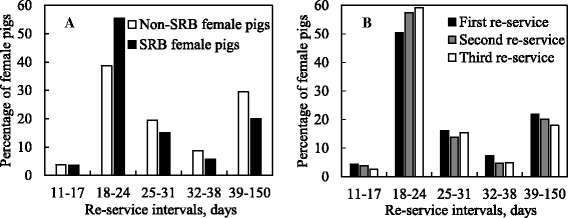Characteristics and risk factors for severe repeat-breeder female pigs and their lifetime performance in commercial breeding herds
- PMID: 28603642
- PMCID: PMC5463492
- DOI: 10.1186/s40813-017-0059-0
Characteristics and risk factors for severe repeat-breeder female pigs and their lifetime performance in commercial breeding herds
Abstract
Background: Repeat-breeder females increase non-productive days (NPD) and decrease herd productivity and profitability. The objectives of the present study were 1) to define severe repeat-breeder (SRB) females in commercial breeding herds, 2) to characterize the pattern of SRB occurrences across parities, 3) to examine factors associated with SRB risk, and 4) to compare lifetime reproductive performances of SRB and non-SRB females. Data included 501,855 service records and lifetime records of 93,604 breeding-female pigs in 98 Spanish herds between 2008 and 2013. An SRB female pig was defined as either a pig that had three or more returns. The 98 herds were classified into high-, intermediate- and low-performing herds based by the upper and lower 25th percentiles of the herd mean of annualized lifetime pigs weaned per sow. Multi-level mixed-effects logistic regression models with random intercept were applied to the data.
Results: Of 93,604 females, 1.2% of females became SRB pigs in their lifetime, with a mean SRB risk per service (± SEM) of 0.26 ± 0.01%. Risks factors for becoming an SRB pig were low parity, being first-served in summer, having a prolonged weaning-to-first-mating interval (WMI), and being in low-performing herds. For example, served gilts had 0.81% higher SRB risk than served sows (P < 0.01). Also, female pigs in a low-performing herd had 1.19% higher SRB risks than those in a high-performing herd. However, gilt age at-first-mating (P = 0.08), lactation length (P = 0.05) and number of stillborn piglets (P = 0.28) were not associated with becoming an SRB female. The SRB females had 14.4-16.4 fewer lifetime pigs born alive, 42.8-91.3 more lifetime NPD, and 2.1-2.2 lower parities at culling than non-SRB females (P < 0.05).
Conclusions: We recommend that producers closely monitor the female pig groups at higher risk of becoming an SRB.
Keywords: Herd productivity groups; Lifetime performance; Severe repeat-breeding.
Figures

Similar articles
-
Culling in served females and farrowed sows at consecutive parities in Spanish pig herds.Porcine Health Manag. 2018 Feb 20;4:3. doi: 10.1186/s40813-018-0080-y. eCollection 2018. Porcine Health Manag. 2018. PMID: 29484195 Free PMC article.
-
Number of pigs born alive in parity 1 sows associated with lifetime performance and removal hazard in high- or low-performing herds in Japan.Prev Vet Med. 2015 Sep 1;121(1-2):108-14. doi: 10.1016/j.prevetmed.2015.06.012. Epub 2015 Jun 19. Prev Vet Med. 2015. PMID: 26119515
-
Culling intervals and culling risks in four stages of the reproductive life of first service and reserviced female pigs in commercial herds.Theriogenology. 2010 Mar 15;73(5):587-94. doi: 10.1016/j.theriogenology.2009.10.014. Epub 2009 Dec 16. Theriogenology. 2010. PMID: 20006377
-
Farm data analysis for lifetime performance components of sows and their predictors in breeding herds.Porcine Health Manag. 2020 Sep 18;6:24. doi: 10.1186/s40813-020-00163-1. eCollection 2020. Porcine Health Manag. 2020. PMID: 32963803 Free PMC article. Review.
-
Factors for improving reproductive performance of sows and herd productivity in commercial breeding herds.Porcine Health Manag. 2017 Jan 9;3:1. doi: 10.1186/s40813-016-0049-7. eCollection 2017. Porcine Health Manag. 2017. PMID: 28405457 Free PMC article. Review.
Cited by
-
Evaluating the Impact of an Organic Trace Mineral mix on the Redox Homeostasis, Immunity, and Performance of Sows and their Offspring.Biol Trace Elem Res. 2025 Apr;203(4):1798-1807. doi: 10.1007/s12011-024-04300-7. Epub 2024 Jul 9. Biol Trace Elem Res. 2025. PMID: 38980512
-
Recurrence patterns and lifetime performance of parity 1 sows in breeding herds with different weaning-to-first-mating intervals.Porcine Health Manag. 2019 Jun 28;5:15. doi: 10.1186/s40813-019-0122-0. eCollection 2019. Porcine Health Manag. 2019. PMID: 31297235 Free PMC article.
-
Culling in served females and farrowed sows at consecutive parities in Spanish pig herds.Porcine Health Manag. 2018 Feb 20;4:3. doi: 10.1186/s40813-018-0080-y. eCollection 2018. Porcine Health Manag. 2018. PMID: 29484195 Free PMC article.
-
High-performing farms exploit reproductive potential of high and low prolific sows better than low-performing farms.Porcine Health Manag. 2018 Jul 16;4:15. doi: 10.1186/s40813-018-0091-8. eCollection 2018. Porcine Health Manag. 2018. PMID: 30026960 Free PMC article.
-
Metabolomics reveals early pregnancy biomarkers in sows: a non-invasive diagnostic approach.Front Vet Sci. 2024 Apr 25;11:1396492. doi: 10.3389/fvets.2024.1396492. eCollection 2024. Front Vet Sci. 2024. PMID: 38725582 Free PMC article.
References
-
- PigCHAMP. PigCHAMP benchmarks. 2015.http://www.pigchamp.com/Portals/0/Documents/Benchmarking%20Summaries/USA.... Accessed 15 Jun 2016.
LinkOut - more resources
Full Text Sources
Other Literature Sources

